Cave Corals
Cave Popcorn - Coralloids
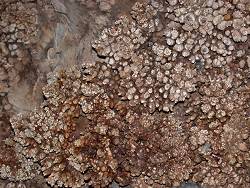
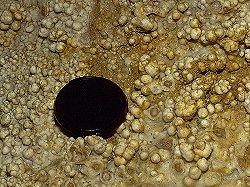
 Laichingen Vertical Cave,
Laichingen Vertical Cave,  Germany.
Germany.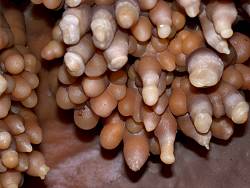
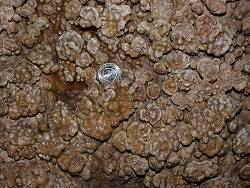
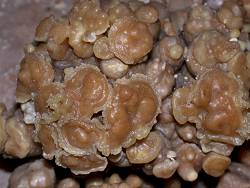
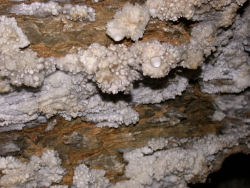


Cave Corals are very small speleothems consisting of short stalks with bulbous ends. As a result of their characteristic forms they are also dubbed Cave Popcorn or Coralloids, sometimes they are called bulbuous calcite, which is actually a wider term and includes other forms of speleothems. They usually occur in groups and cover wall and ceiling surfaces. They have a slightly thinner base or stem and a mostly rounded head. Inside, they are built up in layers, you can clearly see at the fracture surfaces of the damaged cave corals in the pictures. The sinter is therefore similar to the sinter of stalactites, which suggests that they are deposited from a thin film of water. They grow in all directions and ignore gravity. The formation mechanisms for this type of sinter are largely unknown. There are a number of theories, none of which are really convincing, and they are generally only attempts to explain one aspect.
- One theory is that the reason why their diameter is small near the wall is due to the low temperature of the wall itself. The air, which is only a few millimetres away from the wall, is slightly warmer, and so they can grow better there, which means that they are thicker there. However, this would mean that they are covered by a film of water that is not produced by drops from the ceiling, otherwise a stalagmite would form.
- It is possible that cave coral is formed by splashing water. It could then be formed along a cave stream or by the impact of water dripping from the ceiling after a fall from a great height. Unfortunately, huge areas of cave coral are often found without any trace of such a source of splash water.
- One theory is that cave coral grows underwater, while the cave is filled with standing water. However, calcite normally forms crystals in standing water, triangular, or more precisely rhombohedral calcite crystals, which can reach considerable sizes. So there must be a (perhaps chemical) reason why cave coral forms instead.
- And there is an empirical observation by speleologists who noted that cave coral is usually found on walls where the passage narrows and thus there is a much stronger air flow than in the rest of the cave. As far as we know, there is no research on this subject, not even statistical data. There is not even an idea or indication of the internal mechanism of the air currents that influence the growth of speleothems.
- An interesting theory is that cave coral is not formed by the release of CO2 like other dripstones, but actually by the evaporation of the water film.
- Recently, many aspects of speleothems have been attributed to the influence of biological components such as algae and bacteria. A few decades ago, new microscopes were developed that made it possible to see smaller bacteria than before. Scientists could not see them before and assumed that there was a minimum size, but with the new microscopes they became visible. These nanobacteria live in dripping water and their excretions change the chemistry of the water and influence the growth of minerals. In recent decades, scientists have learnt that all speleothems are probably a result of a combination of chemical reaction and biological modification. Pool fingers, for example, can only be explained by a high proportion of biological processes. However, no such explanation has yet been found for cave coral.
- The further theory is that they grow during periodic changes in the water level. Each time the cave coral is flooded for a while, a thin layer of calcite grows. Instead of a single crystal getting bigger and bigger, the crystal gets a new layer of calcite crystals every time it is flooded. This results in the layered structure of cave coral.
- Another aspect is the surface tension of the water. If a film of water flows down the wall, the surface tension draws the water up onto the head and the large surface area causes limescale to be deposited there. This mechanism was even simulated in the laboratory, where sintered buttons were placed in different solutions so that only the feet were immersed. The dissolved material was deposited on the entire head.
- Dave Bunell points out on his website that cave coral occurs both very frequently and in many different forms, as can easily be seen in the pictures. He concludes that cave coral can form under many different conditions. Above water, it forms thin, evenly distributed films of solution, regardless of how this film is formed. But it can also form underwater. So most of the deposits above would probably be part of the solution.
To summarise, cave coral is by far the most mysterious cave mineral. There is no conclusive and reasonably detailed explanation of how they are formed. However, this is probably also due to the fact that there has been no serious scientific work on this speleothem to date. Anyone looking for a topic for a doctoral thesis has an interesting task here.
Literature
- Carol Hill, Paolo Forti (1997): Cave Minerals of the World Second Edition ed. Huntsville, AL: National Speleological Society. pp. 59–61. ISBN 1-879961-07-5.
 Search DuckDuckGo for "Cave Coral"
Search DuckDuckGo for "Cave Coral" Cave popcorn - Wikipedia (visited: 20-MAR-2022)
Cave popcorn - Wikipedia (visited: 20-MAR-2022) Coralloids (visited: 20-MAR-2022)
Coralloids (visited: 20-MAR-2022)
 Index
Index Topics
Topics Hierarchical
Hierarchical Countries
Countries Maps
Maps